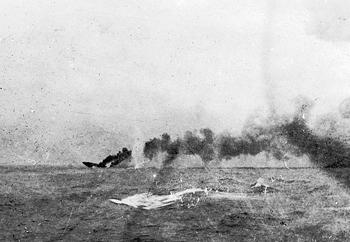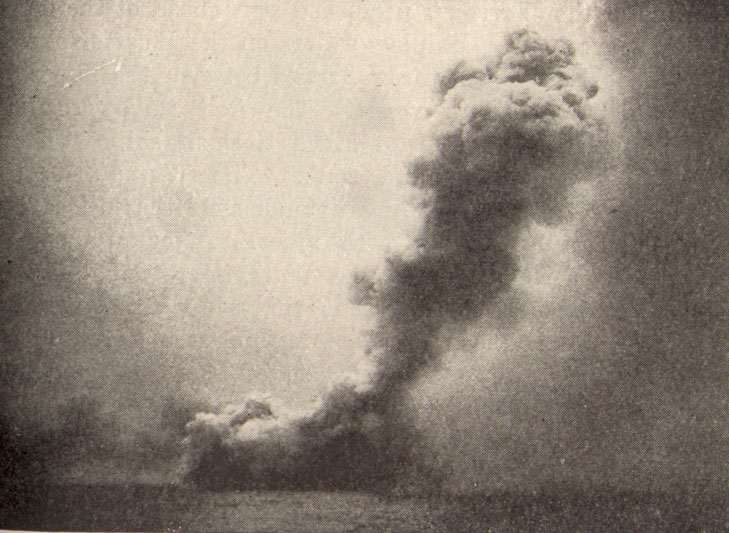|
|
|
|
|
|
|
BATTAGLIA NAVALE DELLO JUTLAND
NAVAL BATTLE OF JUTLAND
|
|
|
|
|
|
|
31 MAGGIO 1916 - 1° GIUGNO 1916


STORIA / HISTORY
LO SCONTRO TRA GLI INCROCIATORI DA BATTAGLIA /
THE FIGHTING AMONG THE BATTLECRUISERS
Mentre gli incrociatori leggeri combattevano fra di loro, comparve, dietro quelli tedeschi, una lunga nuvola di fumo nero; era l'indizio sicuro dell'avvicinarsi di una imponente forza navale ed erano infatti gli incrociatori da battaglia di Hipper.
L'ammiraglio Beatty, per evitare che ancora una volta la flotta tedesca sfuggisse al combattimento, senza attendere il ritorno delle sue 4 supercorazzate della classe Queen Elizabeth, diresse verso sud-est, nell'intenzione di tagliar la strada al gruppo di Hiper. Questi, a sua volta, intuita la consistenza della squadra di Beatty, manovrò per attirarla sotto il fuoco delle navi da battaglia che lo seguivano. In questo modo le due squadre nemiche si trovaron a navigare su due file parallele a circa 14 chilometri l'una dall'altra.
Poco dopo le 15.45 da una distanza di circa 18 chilometri la linea tedesca aprì il fuoco: la prima salva colpì in pieno la Lion, la nave ammiraglia di Beatty, che a causa del terribile incendio divampato a bordo venne costretta a ritirarsi quasi subito, abbandonando la formazione. I britannici risposero al fuoco procurando considerevoli danni alla Seydlitz e alla Lützow, la nave ammiraglia di Hipper, ma pur avendo colpito anche la Derfflinger e la Von der Tann, Beatty era in posizione di svantaggio rispetto ai tedeschi che, trovandosi sotto vento e con una visibilità migliore, erano favoriti nel puntamento.
Dopo aver gravemente danneggiato anche la Tiger, i tedeschi iniziano a lanciare granate dalla Lützow e dalla Von der Tann contro l'Indefatigable, colpendone il deposito munizioni. Gli incrociatori da battaglia britannici non erano sufficientemente attrezzati contro gli incendi, che dalle torrette si diffusero facilmente al deposito munizioni, così, dopo una violenta esplosione, l'Indefatigable affondò, tanto rapidamente che una torpediniera tedesca riuscì a salvare solo 3 marinai dei 1017 imbarcati.
Nel frattempo sopraggiunsero anche le 4 super corazzate veloci al comando del contrammiraglio Evan Thomas; si trattava delle più potenti navi da guerra che avessero mai solcato i mari fino ad allora e il comando britannico era certo che la sua artiglieria da 38 cm avrebbe annientato una volta per tutta la flotta tedesca.
Ma queste speranze furono deluse e lo sbalordimento fu grande nel vedere la maggior parte dei proiettili rimbalzare sulla corazzatura tedesca, senza provocare significativi danni né alla Moltke né alla Von der Tann.
Nel frattempo una colonna di fumo alta 300 metri rivelò che anche l'incrociatore da battaglia inglese Queen Mary era stato colpito. Questi si inabissò con il capitano e tutti i 1266 uomini di equipaggio.
Un particolare patetico: un grande e pacifico "tre alberi" con tutte le vele spiegate ed immobilizzato dalla bonaccia, rimase durante questo scontro fra le due squadre nemiche.
Frattanto anche il Lion, sul quale si trovava l'ammiraglio Beatty, veniva seriamente danneggiato da una "salva" del Lutzow, che distruggeva una delle sue torrette. A questo punto la situazione si faceva critica per gli inglesi. Entrati in contatto col nemico in una situazione di netto vantaggio, dopo 45 minuti di combattimento avevano perduto 2 navi e ne avevano una terza colpita, mentre gli incrociatori tedeschi non avevano subito alcun serio danno.
A mezz'ora dall'inizio dello scontro, i tedeschi avevano già affondato due incrociatori danneggiandone gravemente altri; eppure Beatty contava ancora sulla propria superiorità, credendo di trovarsi davanti all'intera flotta tedesca: non sapeva dell'avanzata di Scheer, come questi ignorava della squadra di Jellicoe, in avvicinamento con 24 navi da battaglia.
THE FIGHTING AMONG THE BATTLECRUISERS
While the light cruisers fought between them, it appeared, behind those German, a long cloud of black smoke; it was the sure sign of the to draw near of an imposing naval strength and they were in fact the battle cruisers of Hipper.
The admiral Beatty, to avoid that once more the German fleet it escaped the fight, without attending the return of his/her 4 supercorazzates of the class Queen Elizabeth, it directed toward southeast, in the intention of tagliar the road to the group of Hiper. These, realized in turn the consistence of the team of Beatty, it maneuvered for attracting her/it under the fire of the battle ships that they followed him/it. In this way the two hostile teams him trovaron to sail on two parallel files to around 14 kilometers the one from the other.
At 15.45 o'clock the Lutzov opened the fire on the English Lion, they were the two leader.
The Lion responded and immediately later also the other 5 British battle cruisers and the 4 Germans opened the fire. The first ship to be stricken, but without excessive damages, it was the Lion. Few minutes after the Princess Royal it struck the Lutzow. To the 16 the Von der Tan succeeded in putting 3 hits of one "hi" of 4 on the Indefatigable that jumped in air. Twenty-five minutes later it was the time of the Queen Mary which, contemporarily centered by the "hi" of the Seydlitz and of the Deerflinger, he set on fire and in the turn of one minute it literally jumped in air bringing with itself 1204 men.
A pathetic detail: a great and pacific "three trees" with all the explained sails and immobilized by the calm, he/she remained during this clash among the two hostile teams.
The Lion, on which the admiral Beatty was found, came also in the meantime seriously damaged by one "salute" of the Lutzow, that destroyed one of his/her turrets. To this point the situation he did criticism for the English. Come into contact with the enemy in a situation of clean advantage, after 45 minutes of fight they had lost 2 ships and they had a stricken bystander of it, while the German cruisers had not suffered some serious damage. After a few minutes also the Princess Royal disintegrated him, centered by one "salute" hostile.
LE PIU' GRANDI BATTAGLIE NAVALI (NAVAL BATTLES)
BATTAGLIA NAVALE DELLO JUTLAND / JUTLAND NAVAL BATTLE
PORTAEREI NELLA STORIA (AIRCRAFT CARRIERS)
NAVI DA GUERRA (WARSHIPS AND BATTLESHIPS)